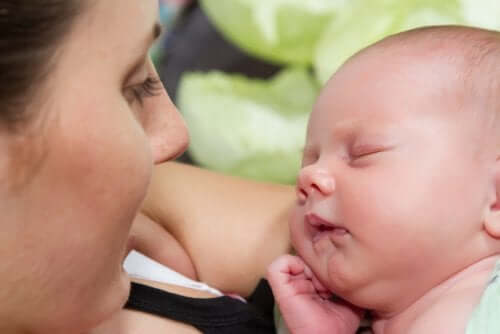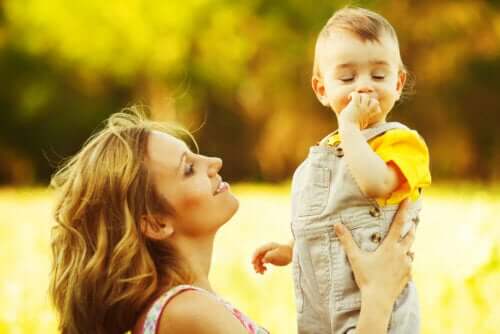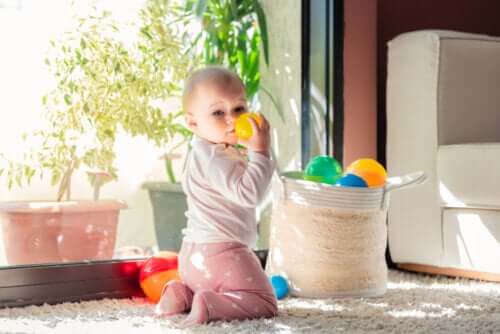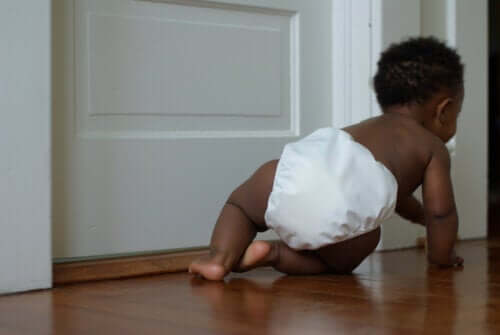The Stages of Development in a Baby's First Year

A baby’s first year consists of an amazing evolution. From newborns who spend most the time sleeping, these tiny humans go on to make tremendous psychomotor advances.
During these first 12 months, babies learn to establish relationships with their environment. They start to learn how to control their bodies, their movements… And they start to communicate using babbles and gurgles and even their first words.
Do you want to know more about the development that takes place during a baby’s first year of life?
Stages of development during a baby’s first year
Below, we’ll look at the different abilities that babies develop during their first year of life. But first, we want to remind you not to worry if your baby’s own development doesn’t coincide with the descriptions below. Remember that every baby develops and evolves at their own pace.
The stages we describe below are generalizations, as children reach developmental milestones in their own time. So, if your little one has yet to develop a certain skill, just be patient.
First developmental stage in a baby’s first year of life

The first month
- Babies communicate by crying when they’re hungry, wet, uncomfortable, or just want to be held.
- During this month, babies move their eyes in search of light. Also, they react to loud noises by stretching their arms and legs (the moro reflex).
- Newborns display other involuntary movements (reflexes) as well. For example, they suck on anything that gets close to their mouths. At the same time, their feet curl downward if you touch their soles, and they open and close their fists.
The second month
- Babies start to smile in response to external stimuli, including familiar faces.
- They can suck on their thumbs.
- At this point, babies emit their first sounds to seek attention.
The third month
- During the third month of life, babies show interest in visual stimuli, especially bright colors.
- They produce their first babbles.
- Babies demonstrate an interest in everything that’s going on around them. We can observe them turning their heads towards sounds.
The fourth month
- Babies start to hold their heads up and pay attention to their hands. They grasp rattles or any other objects they can and shake them.
- During their fourth month of life, babies laugh often and are attracted to people (especially smiling faces).
- During this stage, babies don’t like to be alone.
Second developmental stage of a baby’s first year of life
The fifth month
- Babies present an increase in babbling and like to listen to themselves. They play with the sounds that they make.
- For some children, their first teeth come in during the fifth month.
- Babies can lie down and grab their feet.
- They start to distinguish different colors.
The sixth month
- When lying face down, with help, they can sit up completely and roll over on their own.
- Babies grasp their bottles with their hands and move objects from one hand to the other.
- They reach out their hands in order to communicate that they want someone to pick them up.
- Babies begin to show interest in putting their feet in their mouths.
Third developmental stage in a baby’s first year of life

The seventh month of life
- Babies can sit up on their own without support.
- They have greater agility with their hands and can manipulate any object.
- Babies begin to pronounce their first random syllables.
- During this stage, learning occurs much faster.
The eight month
- Babies begin to display increased fear and weariness around strangers, and may even cry.
- If lying down, they can turn over on their own and enjoy playing on the floor.
Fourth developmental stage in a baby’s first year of life

The ninth month
- Babies like to grab their toys and throw them as a means of experimentation.
- They may sit for up to 15 minutes without assistance.
- Some children start crawling during this month. However, not all babies do, and that’s perfectly normal.
The tenth month
- Babies can stand up on their own by grasping onto furniture or other objects.
- They begin to pronounce their first words, which are often “mom” and “dad.”
- At this age, children like to make noise by banging on everything in sight.
- Babies begin to wave at others with their hands, including strangers.
Fifth stage of development in a baby’s first year of life

The eleventh month of life
- Babies begin to pronounce more words and use them appropriately. They now understand the meaning of words like “give me”, “more”, and “no.”
- Babies begin to walk on their own while holding onto furniture or the hands of an adult. It’s important not to force children to walk if they’re not ready.
A baby’s first birthday
- Babies that haven’t crawled before this point may take their first steps around their first birthday. Those that have crawled may begin to walk a bit later.
- Babies can stand up and also sit down from a sitting position if they’re tired.
- They use their thumbs and index fingers to grasp small objects.
- Babies at this age are very receptive to displays of affection and also begin to express them.
- They grab everything in sight. Therefore, it’s very important to make sure any objects that are dangerous or fragile should stay far out of reach.
Conclusions regarding a baby’s first year
These are the stages of development that take place during a baby’s first year. But that doesn’t mean that all children reach each milestone at the same time. Some things may occur a month earlier or a month later than indicated above, and that’s perfectly normal.
https://eresmama.com/etapas-evolucion-bebe-primer-ano/
A baby’s first year consists of an amazing evolution. From newborns who spend most the time sleeping, these tiny humans go on to make tremendous psychomotor advances.
During these first 12 months, babies learn to establish relationships with their environment. They start to learn how to control their bodies, their movements… And they start to communicate using babbles and gurgles and even their first words.
Do you want to know more about the development that takes place during a baby’s first year of life?
Stages of development during a baby’s first year
Below, we’ll look at the different abilities that babies develop during their first year of life. But first, we want to remind you not to worry if your baby’s own development doesn’t coincide with the descriptions below. Remember that every baby develops and evolves at their own pace.
The stages we describe below are generalizations, as children reach developmental milestones in their own time. So, if your little one has yet to develop a certain skill, just be patient.
First developmental stage in a baby’s first year of life

The first month
- Babies communicate by crying when they’re hungry, wet, uncomfortable, or just want to be held.
- During this month, babies move their eyes in search of light. Also, they react to loud noises by stretching their arms and legs (the moro reflex).
- Newborns display other involuntary movements (reflexes) as well. For example, they suck on anything that gets close to their mouths. At the same time, their feet curl downward if you touch their soles, and they open and close their fists.
The second month
- Babies start to smile in response to external stimuli, including familiar faces.
- They can suck on their thumbs.
- At this point, babies emit their first sounds to seek attention.
The third month
- During the third month of life, babies show interest in visual stimuli, especially bright colors.
- They produce their first babbles.
- Babies demonstrate an interest in everything that’s going on around them. We can observe them turning their heads towards sounds.
The fourth month
- Babies start to hold their heads up and pay attention to their hands. They grasp rattles or any other objects they can and shake them.
- During their fourth month of life, babies laugh often and are attracted to people (especially smiling faces).
- During this stage, babies don’t like to be alone.
Second developmental stage of a baby’s first year of life
The fifth month
- Babies present an increase in babbling and like to listen to themselves. They play with the sounds that they make.
- For some children, their first teeth come in during the fifth month.
- Babies can lie down and grab their feet.
- They start to distinguish different colors.
The sixth month
- When lying face down, with help, they can sit up completely and roll over on their own.
- Babies grasp their bottles with their hands and move objects from one hand to the other.
- They reach out their hands in order to communicate that they want someone to pick them up.
- Babies begin to show interest in putting their feet in their mouths.
Third developmental stage in a baby’s first year of life

The seventh month of life
- Babies can sit up on their own without support.
- They have greater agility with their hands and can manipulate any object.
- Babies begin to pronounce their first random syllables.
- During this stage, learning occurs much faster.
The eight month
- Babies begin to display increased fear and weariness around strangers, and may even cry.
- If lying down, they can turn over on their own and enjoy playing on the floor.
Fourth developmental stage in a baby’s first year of life

The ninth month
- Babies like to grab their toys and throw them as a means of experimentation.
- They may sit for up to 15 minutes without assistance.
- Some children start crawling during this month. However, not all babies do, and that’s perfectly normal.
The tenth month
- Babies can stand up on their own by grasping onto furniture or other objects.
- They begin to pronounce their first words, which are often “mom” and “dad.”
- At this age, children like to make noise by banging on everything in sight.
- Babies begin to wave at others with their hands, including strangers.
Fifth stage of development in a baby’s first year of life

The eleventh month of life
- Babies begin to pronounce more words and use them appropriately. They now understand the meaning of words like “give me”, “more”, and “no.”
- Babies begin to walk on their own while holding onto furniture or the hands of an adult. It’s important not to force children to walk if they’re not ready.
A baby’s first birthday
- Babies that haven’t crawled before this point may take their first steps around their first birthday. Those that have crawled may begin to walk a bit later.
- Babies can stand up and also sit down from a sitting position if they’re tired.
- They use their thumbs and index fingers to grasp small objects.
- Babies at this age are very receptive to displays of affection and also begin to express them.
- They grab everything in sight. Therefore, it’s very important to make sure any objects that are dangerous or fragile should stay far out of reach.
Conclusions regarding a baby’s first year
These are the stages of development that take place during a baby’s first year. But that doesn’t mean that all children reach each milestone at the same time. Some things may occur a month earlier or a month later than indicated above, and that’s perfectly normal.
https://eresmama.com/etapas-evolucion-bebe-primer-ano/
This text is provided for informational purposes only and does not replace consultation with a professional. If in doubt, consult your specialist.








